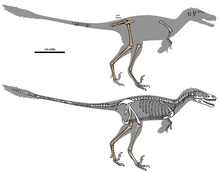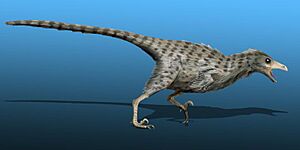Mahakala facts for kids
Quick facts for kids MahakalaTemporal range: Upper Cretaceous
|
|
|---|---|
 |
|
| Mahakala omnogovae | |
| Scientific classification | |
| Kingdom: | |
| Phylum: | |
| Class: | |
| Superorder: | |
| Order: | |
| Suborder: | |
| Family: | |
| Genus: |
Mahakala
Turner et al., 2007
|
| Species | |
|
|
Mahakala was a type of dinosaur called a dromaeosaurid. It lived about 80 million years ago during the Upper Cretaceous period.
Scientists found a partial skeleton of Mahakala in the Gobi Desert in Mongolia.
Mahakala was a small dromaeosaur, only about 70 centimeters (28 inches) long. Its bones show some features also seen in early troodontids and avialans (which are bird-like dinosaurs). However, its short front limbs mean it was not an avialan.
Even though it lived later in dinosaur history, its body structure was like that of earlier, more basic dromaeosaurs. Its small size, and the small size of other early deinonychosaurs, suggests that being small was a common trait before birds learned to fly.
What did Mahakala look like?
Even though this Mahakala was small, similar in size to Archaeopteryx or Mei, it was almost fully grown.
You can tell Mahakala apart from other paravians (like dromaeosaurs, troodonts, and birds) by looking closely at its arm bone (ulna), thighbone, hip bone (ilium), and tail bones.
It had a special second toe with a large claw, which is typical for dromaeosaurs. Mahakala also had very short front limbs compared to other dromaeosaurs.
How is Mahakala classified?
Scientists like Turner and his team studied Mahakala's family tree. They found that Mahakala was the most basic dromaeosaur known. Their findings, along with the small size of other theropods at the start of paravian groups, suggest that being small was not just for early birds. Instead, it was a common feature for many early paravians.
In evolution, being small likely came before the ability to fly. Like birds, troodonts and dromaeosaurs did not stay small forever. They grew larger at different times in their evolutionary history.
Mahakala also has a mix of features found in early troodonts and birds. It is missing some features that are present in more advanced dromaeosaurs.
Where did Mahakala live?
The area where Mahakala lived had a dry climate with sand dunes and loose soil. This dry, grassy land had streams that flowed after rain. It was also affected by dust and sandstorms. Rainfall was low and happened only at certain times of the year.
Animals living there included land turtles, crocodilians, lizards, mammals, and many different dinosaurs. There were no aquatic animals like fish. Most of the animals were small to medium-sized.
Small coelurosaurs were the most common dinosaurs. These included other dromaeosaurids like Velociraptor, troodonts like Byronosaurus and Saurornithoides, and oviraptors like Citipati, Khaan, and Oviraptor. There were also alvarezsaurs like Mononykus and Shuvuuia. Other dinosaurs found there were the ceratopsian Protoceratops and the ankylosaur Pinacosaurus.
Like other dromaeosaurs, Mahakala was likely a small, active predator that ate meat.
See also
 In Spanish: Mahakala (Dharmapala) para niños
In Spanish: Mahakala (Dharmapala) para niños



